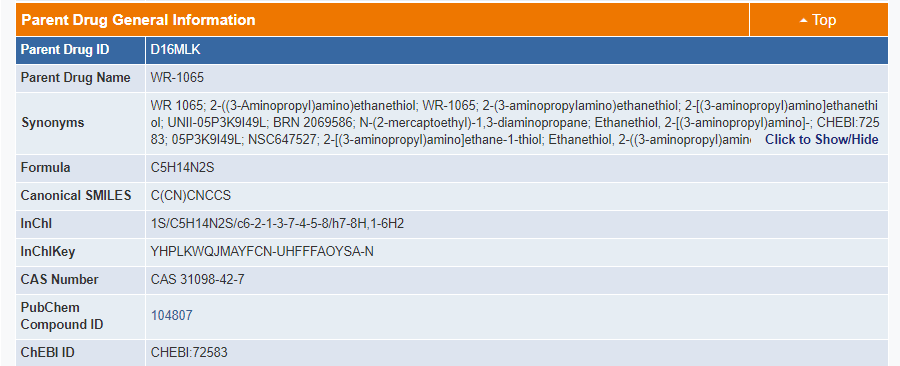1. Search for targets
In the field of "Search for targets", user can find target entries by searching target name, drug name, disease name and so on among the entire textual component of TTD. Target information can be accessed via crosslink to UniProtKB, PDB, KEGG, OMID and Brenda databases from the following search field. Related target or drug entries can be recursively searched by clicking a disease or drug name.
Queries can be submitted by entering keywords into the main searching frame. User can specify part or full target name, drug name, or any other target related information in the text field. Moreover, user can search by put target, drug or other information together into the text field (separated by space or tab) for narrowing the output results. In order to facilitate a more customized input query, the wild characters of "*" and "?" are also supported.
(1). If search: "Alpha receptor", finds entries with targets names including "Alpha adrenergic receptor" or "Alpha platelet-derived growth factor receptor" etc;
(2). If search: "Oseltamivir Influenza", finds only entry with targets name "Neuraminidase";
(3). If search: "Adrenergic receptor", finds entries with target names including "adrenergic receptor" such as "Alpha adrenergic receptor" or "Beta adrenergic receptor" etc;
(4). If search: "Alpha-1? adrenergic receptor", finds entries with target names like "Alpha-1A adrenergic receptor", "Alpha-1B adrenergic receptor" or "Alpha-1C adrenergic receptor" etc. Here, "?" represents any one character;
(5). If search: "Alpha-* adrenergic receptor", finds the same entries as above. Here "*" represents a string of any length. In this case, it represents "1A", "1B" or "1C" respectively.
2. Search for drugs
In the field of "Search for drugs", user can find drug entries by searching drug name, disease name, target name and so on among the entire textual component of TTD. Drug information can be accessed via crosslink to PubChem, DrugBank, SuperDrug and ChEBI from the following search field. Related target or drug entries can be recursively searched by clicking a disease or drug name.
Queries can be submitted by entering keywords into the main searching frame. User can specify part or full target name, drug name, or any other target related information in the text field. Moreover, user can search by put target, drug or other information together into the text field (separated by space or tab) for narrowing the output results. In order to facilitate a more customized input query, the wild characters of "*" and "?" are also supported.
(1). If search: "Alpha receptor", finds entries with targets names including "Alpha adrenergic receptor" or "Alpha platelet-derived growth factor receptor" etc;
(2). If search: "Oseltamivir Influenza", finds only entry with targets name "Neuraminidase";
(3). If search: "Adrenergic receptor", finds entries with target names including "adrenergic receptor" such as "Alpha adrenergic receptor" or "Beta adrenergic receptor" etc;
(4). If search: "Alpha-1? adrenergic receptor", finds entries with target names like "Alpha-1A adrenergic receptor", "Alpha-1B adrenergic receptor" or "Alpha-1C adrenergic receptor" etc. Here, "?" represents any one character;
(5). If search: "Alpha-* adrenergic receptor", finds the same entries as above. Here "*" represents a string of any length. In this case, it represents "1A", "1B" or "1C" respectively.
3. Search drugs and targets by disease or ICD identifier
In this field, users can search TTD target and drug entries related to a specific disease or an ICD-9-CM or ICD-10-CM code. There is a need to enable data retrieval by using the widely used International Classification of Diseases (ICD) codes for facilitating broader, more convenient and automatic data access, processing and exchange by the bench-to-clinic communities, particularly non-domain experts. ICD has been developed by the World Health Organization (WHO), sponsored by the United Nations, adopted by >110 countries and used by physicians, researchers, nurses, health workers, health information managers, policy makers, insurers and health program managers for defining and studying diseases, monitoring and managing health care and allocating resources. ICD codes have been regularly revised to the current version ICD-10. But the previous version ICD-9 is still used by some organizations while proceeding with the transition to ICD-10. In TTD, users can search TTD target and drug entries by inputting a specific disease name to or selecting a certain ICD code from the following search field.
For example: if search "Alzheimer's disease" or "ICD9:331"or "ICD10:G30", users can access to relevant targets and drugs information with this disease or ICD code.
4. Search for biomarkers
The TTD biomarker entries can be searched by selecting a disease name and ICD code and search other biomarker related information from the following search field.
Biomarkers have been developed as non-invasive tests for early detection and indication of disease risks, monitoring of disease progression and recurrence and classification of disease subtypes and patient subpopulations for providing the most appropriate treatments. As many therapies have been found to elicit markedly different clinical responses in individual patients, there is a particular need for more biomarkers capable of predicting drug response in individual patients, which has led to intensive efforts in the discovery of such biomarkers. Table 2 gives examples of the approved and clinically tested biomarkers for facilitating the prescription of a particular drug to specific patient subpopulation. Moreover, there are considerable interests in adopting the multi-marker strategy for parallel evaluation of multiple existing and novel biomarkers in the diagnosis and prognostics of diseases and treatment responses in individual patients. These efforts may be facilitated by significantly expanding biomarker coverage in the biomarker databases. We, therefore, searched literature reported biomarkers, mapped them to the ICD-9-CM and ICD-10-CM codes and added the relevant information and ICD code search tools in TTD. /p>
Overall we collected 1755 biomarkers for 365 disease conditions, which include both process biomarkers (genetic mutations or alterations, gene amplification and levels of proteins, gene expression, microRNAs, small molecules, or metabolites that capture a molecular/biochemical aspect of disease pathogenesis and the biological responses to the disease process and/or treatment) and global biomarkers (such as tumor sizes, brain structures in neurodegeneration and shape of cells in anemia). Based on the literature descriptions, our collected biomarkers were classified into one or more of the 12 classes.
5. Search for drug scaffolds
Users can search the TTD drug and target entries related to a drug scaffold by selecting from the list of drug scaffold names in the following "Search for drug scaffolds" field.
The approved and clinical trial drugs are composed of a limited number of molecular scaffolds in contrast to the high number of bioactive molecular scaffolds. For instance, many drugs have been derived from individual scaffold groups such as macrocycles, and 12 FDA-approved anticancer kinase inhibitor drugs are grouped into three scaffold groups. Investigation and exploration of these highly privileged drug scaffolds are important for discovering new drug-like scaffolds, molecular analogs and drugs. To support the relevant efforts, we searched the literatures for the molecular scaffolds of the approved and clinical trial drugs or their drug leads. By using the combination of keywords drug name or alternative name, 'scaffold', 'discovery', 'synthesis' to search the PubChem database, we found 210 scaffolds for 714 drugs and drug leads.
6. Search for target via sequence similarity
Besides traditional keywords search, TTD also supplies target sequence similarity query for searching similar sequences against all therapeutic targets with available sequence information. The similarity degree of those identified targets will be evaluated by BLAST program, and then be displayed onto your web browser. Identified targets are listed out in the order of their E-value (from the smallest to the largest). Similarity targets of an input protein sequence in FASTA format can be searched by using the BLAST sequence alignment tool. Input query sequence should be provided in FASTA format, which is shown in the above query box.
7. Pathway Affiliation Search
Drug action depends not only on the direct modulation of its target but also on other regulatory factors within the complex biological networks and physiological systems. Advances in systems biology and bioinformatics have revealed some of these mechanisms at the network and physiological levels, which open more opportunities for the development of new polypharmacology strategies to more effectively treat the diseases. These coupled with the knowledge of target affiliated and drug targeted pathways, including those of the clinical trial and investigational drugs as well as those of the approved drugs, is highly useful for facilitating the development of the novel polypharmacology based drug discovery.
A user can search the target affiliated and drug targeted KEGG or PathWhiz or WikiPathways pathway entries by clicking the "Pathway Affiliation Search" field in the TTD homepage, which leads to the TTD pathway affiliation search page wherein the user can conduct the search by inputting a specific drug or target name, or by selecting a particular pathway entry from the lists of KEGG, PathWhiz and WikiPathways pathway entries respectively. The search by a drug or target name leads to a page wherein the user can select to display the target affiliated or the drug targeted KEGG, PathWhiz or WikiPathways pathway entries respectively. In the respective target affiliated or drug targeted pathways page, the user can further select other targets affiliated to or other drugs targeting the same pathway entry.
8. QSAR Models
QSAR models for active compounds against many different targets have been developed and explored for drug lead discovery and optimization. Current TTD includes 841 QSAR models for active compounds of 228 distinct chemical types against 121 targets (71 of the targets are successful target, 20 are clinical trial and 30 are research targets).
User can select the relevant model for a particular chemical class against a specific target either from the target name list or the chemical type list. The retrieved QSAR model page contains the information about target and ID, target species, chemical type, compound mode of action, QSAR models, the molecular descriptors in the QSAR models, references and hyperlinks to the molecular descriptor computation web servers MoDeL and e-dragon.
9. Target Validation
Target validation has been routinely performed to demonstrate the functional role of the potential target in disease phenotype and the ability of drug-like molecules to modulate the activities of the target to achieve therapeutic efficacies. TTD TARGET VALIDATION provide drug target validation information that include drug potency against target, drug potency against disease model, and the results of target gene knockout/genetic variation in animal models. Currently, TTD provides complete or partial validation information for 932 targets (351 successful, 252 clinical trial, 34 discontinued and 295 research targets).
Target validation data can be retrieved by clicking the 'Target Validation' field in the TTD home page, which lead to the TTD target validation information page wherein a user can select the relevant data for a particular target from the target name list to search.
10. Multi-Target Agents
Multi-target agents directed at selected multiple targets have been increasingly explored for enhanced therapeutic efficacies, improved safety profiles and reduced resistance activities by simultaneously modulating the activity of a primary target and the counteractive elements.
These multi-target agents can be retrieved by clicking the 'Multi-Target Agents' field in the TTD home page, which lead to the TTD multi-target agents page wherein a user can right click the 'Click to Save' button to download the multi-target agents against a specific target pair from the target pair list.
11. Drug Combinations
When two drugs produce the same broad therapeutic effect, their combination collectively produces the same effects of various magnitudes in contrast to the summed response of the individual drugs. A drug combination is pharmacodynamically synergistic, additive or antagonistic if the effect is greater than, equal to or less than the summed response of the individual drugs . A drug combination is pharmacodynamically synergistic, additive or antagonistic if the effect is greater than, equal to or less than the summed response of the individual drugs. The types of drug combinations provided in TTD are listed as below:
(1). Pharmacodynamically synergistic drug combinations due to anti-counteractive actions
(2). Pharmacodynamically synergistic drug combinations due to complementary actions
(3). Pharmacodynamically synergistic drug combinations due to facilitating actions
(4). Pharmacodynamically additive drug combinations
(5). Pharmacodynamically antagonistic drug combinations
(6). Pharmacokinetically potentiative drug combinations
(7). Pharmacokinetically reductive drug combinations
These drug combinations and their combination mechanisms can be accessed by clicking the 'Drug Combinations' field in the TTD home page, which lead to the TTD drug combinations page wherein a user can click the 'Click to Save' button to download the relevant drug combination data from the drug combination type list.
12. Natural Product-Derived Drugs
There is a renewed interest in natural products as sources for drug discovery. Knowledge of the natural sources of drugs, the species origins of the natural product-derived approved, clinical trial and pre-clinical drugs, are highly useful for facilitating the search and development of new drug leads.
These natural product derived drugs and their species origins and families can be retrieved by clicking the 'Nature-Derived Drugs' field in the TTD home page, which lead to the TTD natural product-derived drugs page wherein a user can click the 'Click to Save' button to view the list and right click to download the relevant data from the drug status list.
13. TTD Data Downloads
TTD provides functions for downloading all TTD data including cross-matching ID between TTD drugs and public databases, drug and target to disease mapping with ICD identifiers, biomarker to disease mapping with ICD identifiers, target information, drug structure information and pathway information. A user can click the 'Click to Save' button to download all target related information in raw format.
14. Target Expression Profile
Target expression level is useful information for target identification and drug discovery. User can search target expression level between normal tissue and disease tissue, or in different normal tissue by target name or disease, then get the values of Fold-change / Z-score / P-value, and target distribution histogram.
We collected 87,310 raw data generated on the human gene expression array Affymetrix U133 Plus 2.0 Array (GPL570) from the public databases Gene Expression Omnibus and ArrayExpress. We get 2,538 samples after we screen for human genome studies and applied strict [PMID: 20379172]. According the GSE description information, we record the studied disease, as well as sample tissue. Then get the gene expression from analysis chips with same disease and tissue. "Scaling methods" and "Z score transformation" provides the way of normalizing and standardizing data across a wide range of experiments and allows the comparison of microarray data independent of the original hybridization intensities. "Scaling methods" is to choose a baseline array, in particular, the array having the median of the median intensities (excluded the highest and lowest 2% of probe intensities), and then all arrays are normalized to this 'baseline' [PMID: 12538238]. We used Z scores to compare several different methods for predicting significant changes in gene expression including fold changes, Z ratios, Z and t statistical tests. Z score transformation approach for microarrays corrects data internally within a single hybridization and hybridization values for individual genes are expressed as a unit of SD from the normalized mean of zero [PMID: 12707371]. We used the R package "affy" and "ggplot2" for calculating gene expression levels and bar plot.
These Target Expression Profiles can be retrieved by clicking the 'Target Expression Profiles' field under Patient Data in the TTD home page, which lead to the TTD Target Combination page.
A user can search the target expression level by target name or Target ID in the "Search Target Expression Entries" field. Target information including Target Name, Target Type, Disease can be accessed, the EXP Info button link to Target Expression Level information page. The user can also search target expression level information by clicking "Search Target Expression Entries by Target Name", "Search Target Expression Entries by Target Family Name", "Search Target Expression Entries by Disease Name", "Search Target Expression Entries by Tissue Name".
For example, if you want to know the expression of Epidermal growth factor receptor (EGFR) in lung tissue, you can search it's expression information by searching "epidermal growth factor receptor" in the "Search Target Expression Entries:" field or selecting "epidermal growth factor receptor" in the "Search Target Expression Entries by Target Name" drop-down box.
Search "epidermal growth factor receptor" in the "Search Target Expression Entries:" field.

Alternatively, select "epidermal growth factor receptor" in the "Search Target Expression Entries by Target Name" drop-down box.
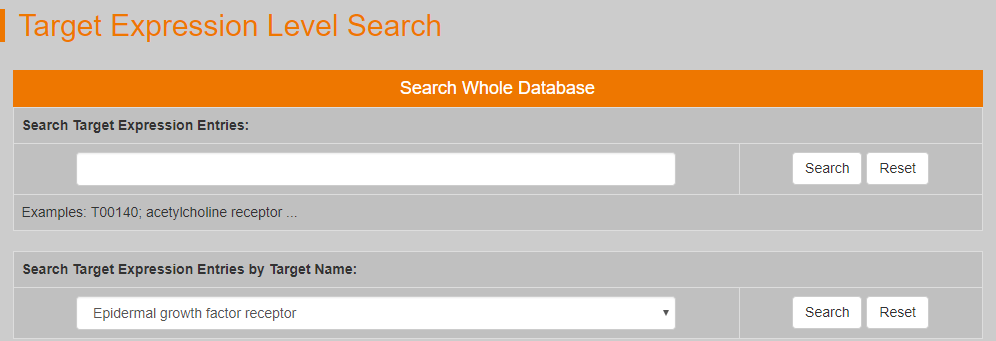
Search result List of targets with expression level information, the EXP Info button link to Target Expression Level information page.

Target Expression Level information page, "Target's Expression Profile across Various Tissues of Healthy Individual" display the expression level of EGFR in different tissues. You can download the expression profile of EGFR between various tissues by clicking "Download the Profile" button.
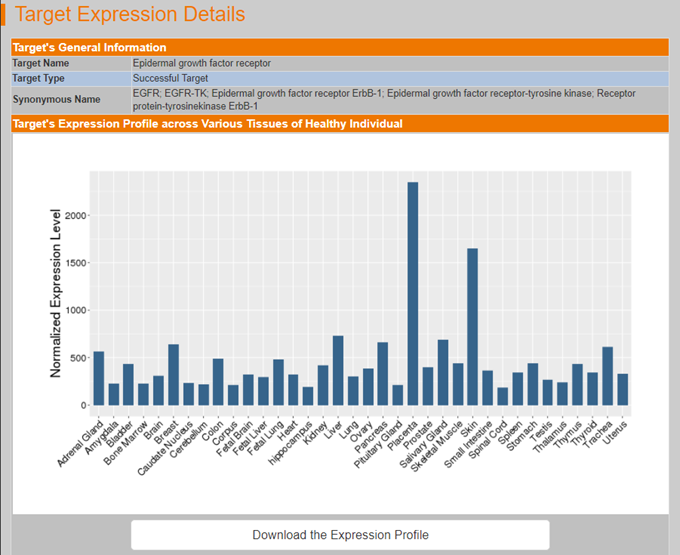
Target Expression Level information page, "Target's Expression Profile in Disease Related Tissue between Patients and Normal People" display the expression level of EGFR between patients and Normal people in different disease. In the following figure, bar chart depicting the normalized expression level between healthy people and patient with Glioma in Brainstem tissue, and each bar represent a sample. You can download the expression profile of EGFR in patients by clicking "Download target expression data in individual patients" button; download the expression profile of EGFR in patients by clicking "Download dataset of target expression data in healthy individuals".
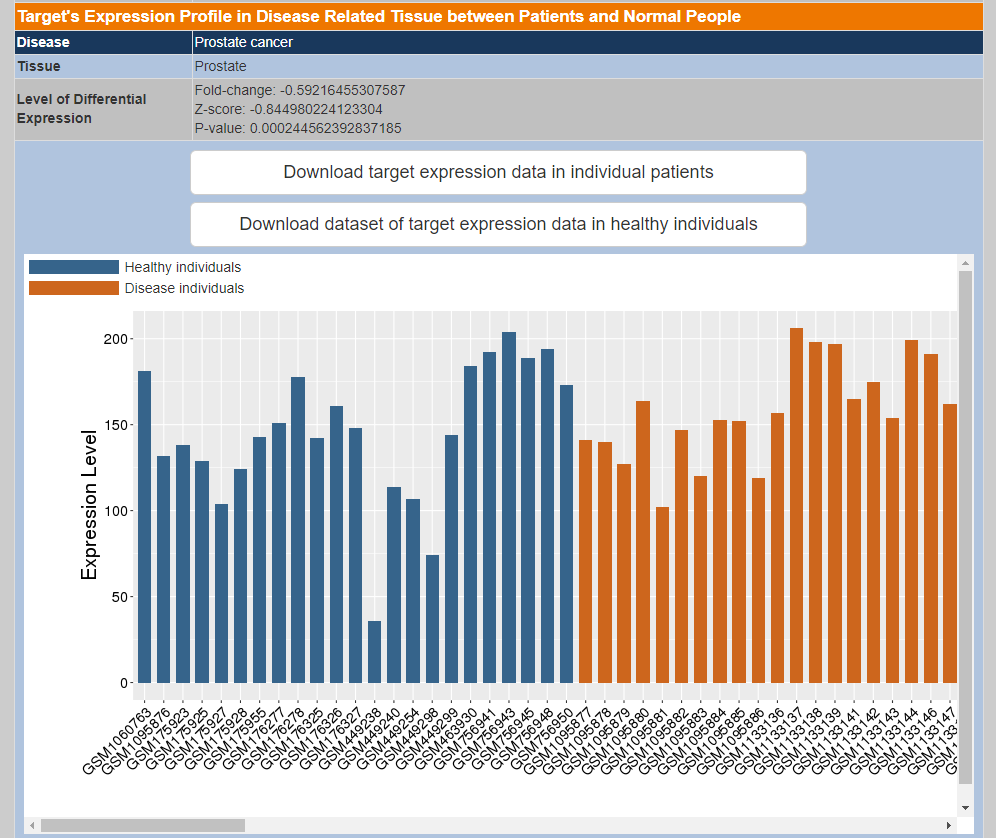
In the following figure, bar chart depicting the normalized expression level between healthy people and patient with Gastric cancer in Gastric tissue.

15. Drug Resistance Mutations
TTD provides the information of drug resistance mutations on 199 proteins targeted by 236 drugs which are used for treating 67 diseases (as shown in table below). Moreover, the mutation frequency information of 49 proteins targeted by 61 drugs treating 21 diseases is also covered by TTD.
These Drug Resistance Mutation can be retrieved by clicking the 'Drug Resistance Mutations' field under Patient Data in the TTD home page, which lead to the TTD Drug Resistance Mutation page.
In the field of "Search for drugs", user can find drug entries with Drug Resistance Mutation information (DRM Info) by searching drug name, disease name, target name and so on among the entire textual component of TTD. Drug information including Drug Name, Drug Status, Disease, Structure, Drug ID can be accessed and the DRM Info button link to Drug Resistance Mutation information page. Search for targets In the field of "Search for targets", user can find target entries with Drug Resistance Mutation information (DRM Info) by searching target name, disease name, drug name and so on among the entire textual component of TTD. Target information including Target Name, Target Type, Disease, Drug Name, TTD Drug ID can be accessed, the DRM Info, TRM Info button link to detail Drug Resistance Mutation information page and detail Drug Resistance Mutation information in this target.
For example, if you want to know which kinase resistance to imatinib, you can search "imatinib" in the "Search for drugs" field.

Search result shows imatinib is an approved drug and treat Chronic Myeloid leukemia, DRM Info button link to the detail information page with imatinib

In Drug resistance mutation page, Drug's General information display drug synonymous, company status information.

Many point mutations in the kinase domain that impair imatinib binding to its' target. Drug Resistance Mutation(s) display the mutations in different targets, such as ABL1, KIT, PDGFRA, BRAF and DDR1. Mutation ": Y253H" means tyrosine 311 was mutated into histidine.
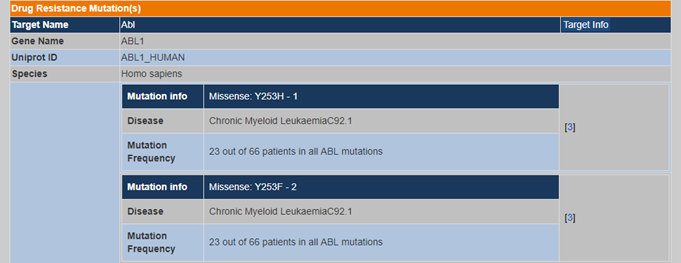

Other mutations in different targets that resistant to imatinib.
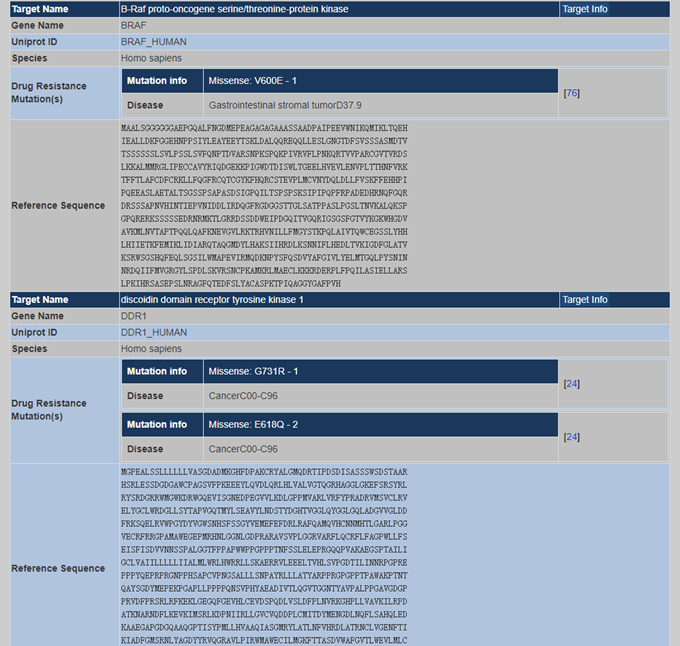
If you want to know the mutations in a particular target, for example, ABL1, you can search "Tyrosine-protein kinase ABL1" in the "Search for targets" field.

Search result shows is an Tyrosine-protein kinase ABL1 successful target associated with Acute promyelocytic leukemia (APL) and other diseases, TRM Info button link to the detail information page with Tyrosine-protein kinase ABL1.

TRM Info link to target associate with drug resistance mutation, Target's General information display target synonymous, target type, synonymous, gene name, uniprot ID species and protein sequence information.
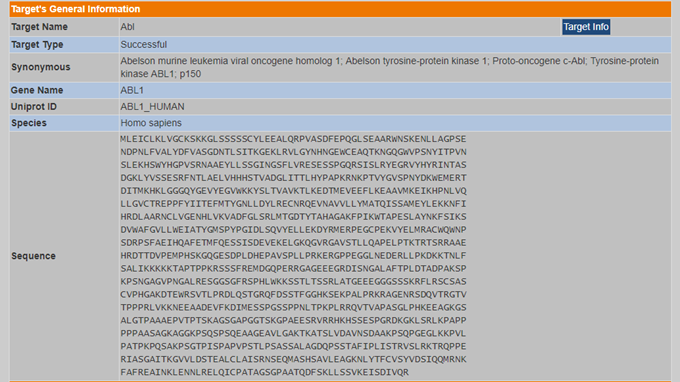
Drug(s) and Correspoding Drug Resistance Mutation display the mutations that resistant to different drugs, such as Imatinib, Axitinib, Bosutinib, Cabozantinib, Dasatinib, Imatinib, Nilotinib, Ponatinib, and Vandetanib. Mutation ": Y253H" means tyrosine 311 was mutated into histidine.
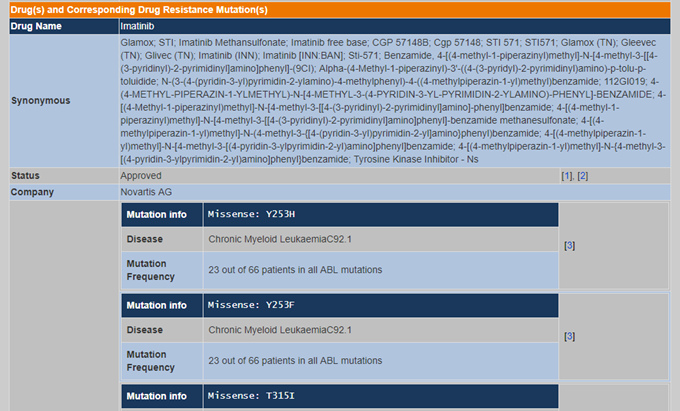
Other mutations in Tyrosine-protein kinase ABL1 that resistant to different drugs.
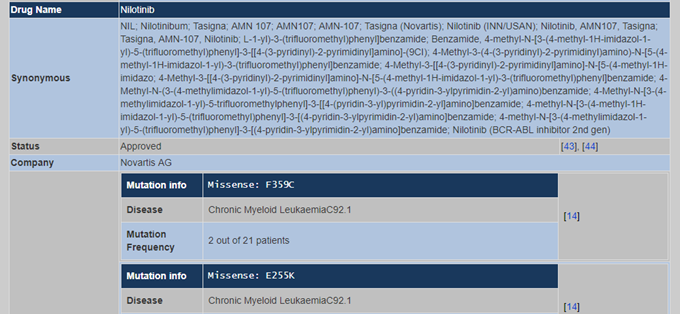
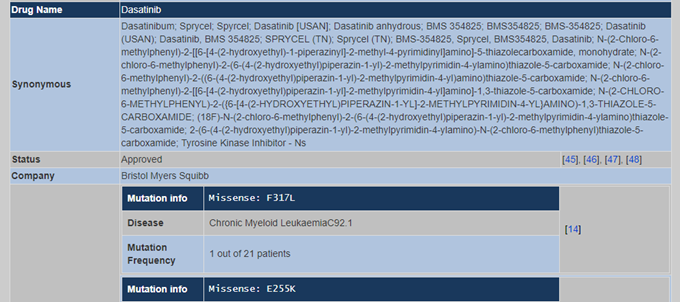
16. Target Combination
Combination of drugs and multi-target drugs contribute to target combinations, such as VEGFR2 + c-Kit (lenvatinib) and EGFR + ABL1 (nilotinib + cetuximab). These target combinations are important in innovative drug discovery. Based on our previous studies between Multi-Target Drugs and Combination Products in Human Kinome, the multi-target drugs inhibited target pairs in the similar target family, while the combination Products tended to target the much more diverse sets of target pairs. In the target combination site, TTD provide target information including target family, target structure fold, pathways, and species.
These Target Combination can be retrieved by clicking the 'Target Combination' field under Targets/Drugs Group in the TTD home page, which lead to the TTD Target Combination page.
Users can search the target combination by searching target name or TTD target ID in "Search Target Combination Entries" field. Search result list all the target combination and example drugs with this target. The TC Info button link to target combination information page and the DC Info button link to drug combination page. Users can also search the TTD target combination entries by selecting from "Search Target Combination Entries by Target Pair" field, "Search Target Combination Entries by Pathway Pair involved by Target" field, "Search Target Combination Entries by Target Species Pair" field, "Search Target Combination Entries by Target Family Pair" field, "Search Target Combination Entries by Target Structural Fold Pair" field. For example, the "Search Target Combination Entries by Target Family Pair" drop-down box list all the target family pairs in TTD, users can select one family name in the first drop-down box, the second drop-down box will display the corresponding family pair that have target combination. Users can also select only one drop-down box to search for target combination, so that all of the target combinations for this drop-down box will appear.
For example, if you want to know the target combinations contain epidermal growth factor receptor (EGFR), you can search epidermal growth factor receptor in the "Search Target Combination Entries:" field, search result will list all the target combinations with EGFR.

Search results list all the target combinations contain EGFR, the TC Info button link to detail target combination information page, the DC Info link to drug combination page and each target id link to target detail information page.

TC Info link to the target combination page, General Information list each target detail information including target family, target structure fold, pathways and species of target in this target combination. In addition, Drug(s) Targeting this TC list all the drugs or drug combinations target on this target combination.


You can also select epidermal growth factor receptor in the first drop-down box of "Search Target Combination Entries by Target Pair:" field, then clicking the second drop-down box will display other target names formed target combination with EGFR. When you select Tyrosine kinase erbB2, search result will list all the target combinations contain epidermal growth factor receptor and Tyrosine kinase erbB2.

Search results list all the target combinations contain EGFR and Tyrosine kinase erbB2, the TC Info button link to detail target combination information page, the DC Info link to drug combination page. Each target id link to target detail information page Drug Info link to detail drug information page.
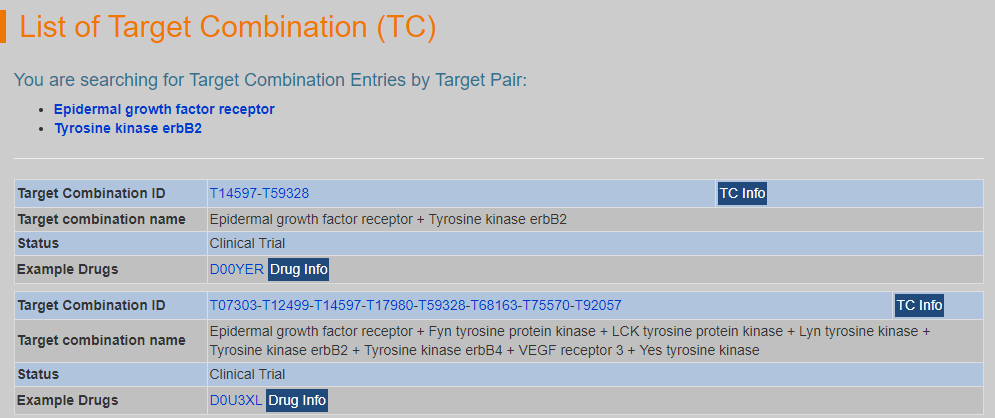
TC Info link to the target combination page, General Information list each target detail information including target family, target structure fold, pathways and species of target in this target combination.
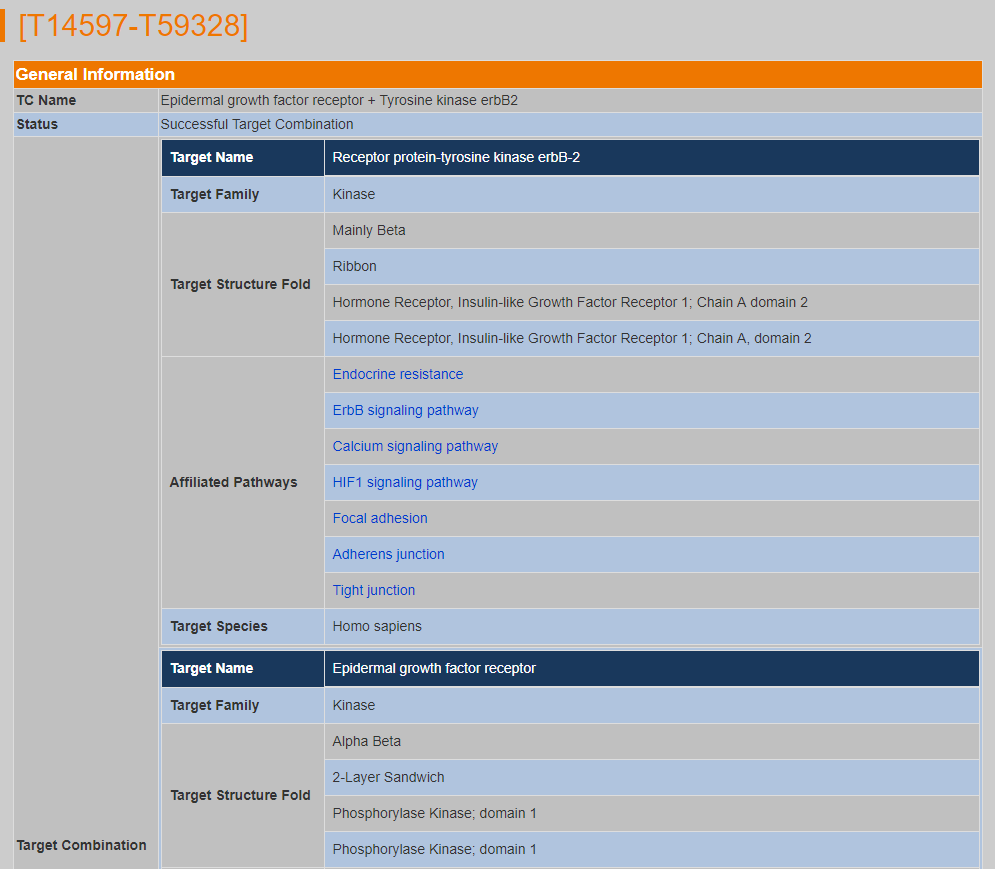
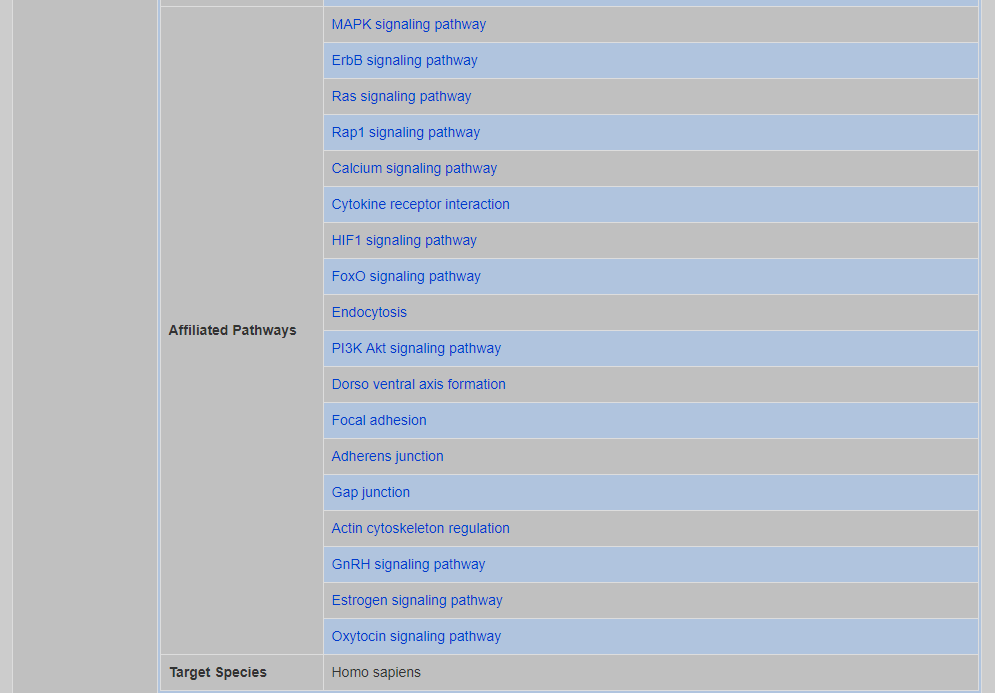
Drug(s) Targeting this TC list all the drugs or drug combinations target on this target combination were list.
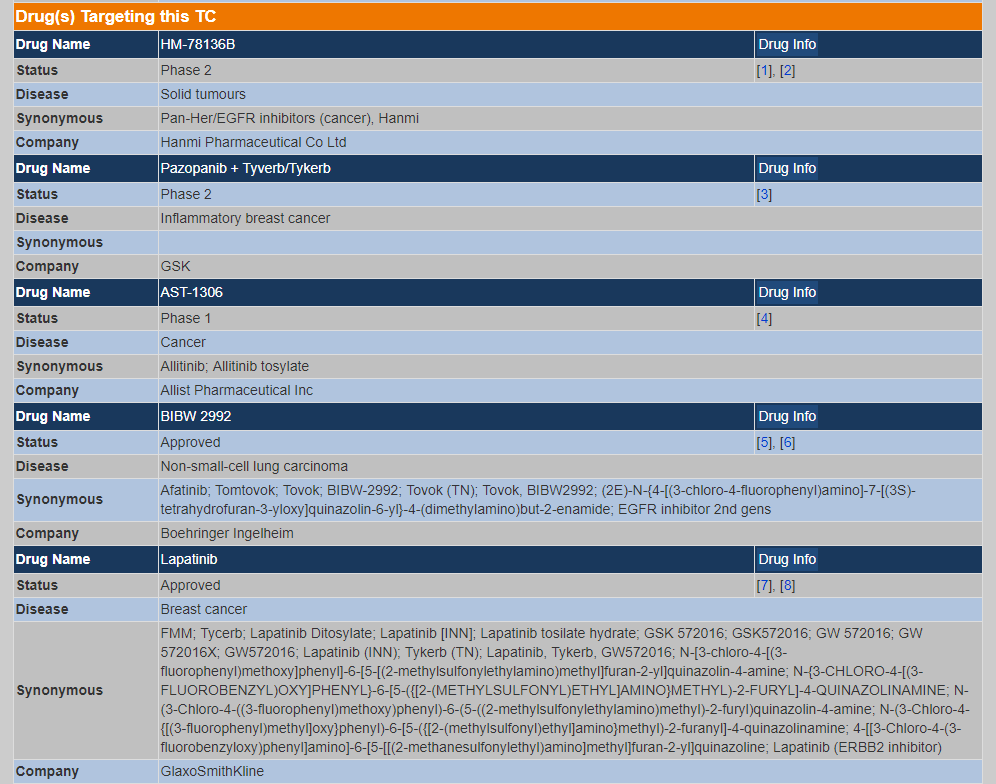
17. Search for Targets of Patented Agents
TTD provides the patent information on 4,865 patented therapeutic agents from 3,145 patents targeting 402 targets. Moreover, 3,880 agents have 3D structure and 3,070 agents have experimental activity value.
Users can search the patented target by searching target name, compound class, disease class, patent ID in "Search the Patented Targets" field. Users can also search the TTD patented targets by selecting from "Search the Patented Targets by Target Name" field, "Search the Patented Targets by Target Family" field, "Search the Patented Targets by the Compound Class of Patented Drug" field, "Search the Patented Targets by ICD-11 Defined Disease Class" field. Search result list all the target and patent information with this target. The Patent Info button links to target and its patented drug(s) page.
For example, if you want to know patent information about pyruvate dehydrogenase kinase, you can search "pyruvate dehydrogenase kinase" in the "Search the Patented Targets" field.

Search result shows pyruvate dehydrogenase kinase is a patented target and is associated with cancer and tumor invasion and metastasis. The Patent Info button links to the detail information page with pyruvate dehydrogenase kinase.

In Target and Its Patented Drug(s) page, Target's General information displays Target Synonyms, Target Type, Gene Name, Biochemical Class, and UniProt ID.

Patent(s) and the Corresponding Patented Drug(s) display the different patent with patent ID, title, abstract, and applicant(s) and its representative patented agents that targeted pyruvate dehydrogenase kinase and its experimental activity value. Moreover, the Click to Show More button can be clicked if this patent has more than one agents. Drug Info button links to the detail information page with patented agents.

18. Search for Patented Agents
TTD provides the patent information on 4,865 patented therapeutic agents from 3,145 patents targeting 402 targets. Moreover, 3,880 agents have 3D structure and 3,070 agents have experimental activity value.
Users can search the patented therapeutic agents by searching compound class, disease class, target name, patent ID in "Search Patented Drugs" field. Users can also search the TTD patented targets by selecting from "Search Patented Drugs by the Compound Class of Patented Drug" field, "Search Patented Drugs by ICD-11 Defined Disease Class" field, "Search Patented Drugs by Target Name" field, "Search Patented Drugs by Target Family" field. Search result list all the patented agents. The Drug Info link to detail drug information page.
19. Search for Small Molecule Agents of Immunotherapy Targets
TTD provides the drug information on 160 small molecule agents (2 phase 1 drugs, 115 patented agents, 1 preclinical agent and 42 investigative compounds) targeting 6 immunotherapy targets (PD-1, PD-L1, PD-1/PD-L1 PPI, CD80/PD-L1 PPI, HAV TIM3 and V-type immunoglobulin domain-containing suppressor of T-cell activation). Moreover, 119 agents have images structures and 59 agents have 3D structures.
Users can search the small molecule agents of immunotherapy targets by searching compound class, target name and disease name in "Search the Small Molecule Agents of Immunotherapy Targets" field. Users can also search the TTD small molecule agents of immunotherapy targets by selecting from "Search the Small Molecule Agents of Immunotherapy Targets by Compound Class" field, "Search the Small Molecule Agents of Immunotherapy Targets by Target Name" field. Search result list all the small molecule agents. The Drug Info link to detail drug information page.
20. CAR T-Cell Therapy Data Search
TTD provides the target information on 54 targeted antigens of 357 clinical trial CAR-T therapies against 126 diseases.
Users can search targets with CAR T-Cell therapy data by searching target name and disease name in "Search the Targets with CAR T-Cell Therapy Data" field. Users can also search the targets by selecting from "Search the Targets with CAR T-Cell Therapy Data by Target Name" field, "Search the Targets with CAR T-Cell Therapy Data by Target Family" field, "Search the Targets with CAR T-Cell Therapy Data by ICD-11 Defined Disease Class" field. Search result list all the targets with CAR T-Cell therapy data. The CAR T-Cell Therapy Info link to detail target and its�� CAR T-Cell Therapy Drug(s) information page. For example, if you search "CD33", you will find only entry with target named "Myeloid cell surface antigen CD33 (CD33)". And you can click "CAR T-Cell Therapy Info" to get targeted Antigens of CAR-T Cell Therapy Information, which includes two components of Target General Information and Targeted Antigens of CAR-T Cell Therapy.
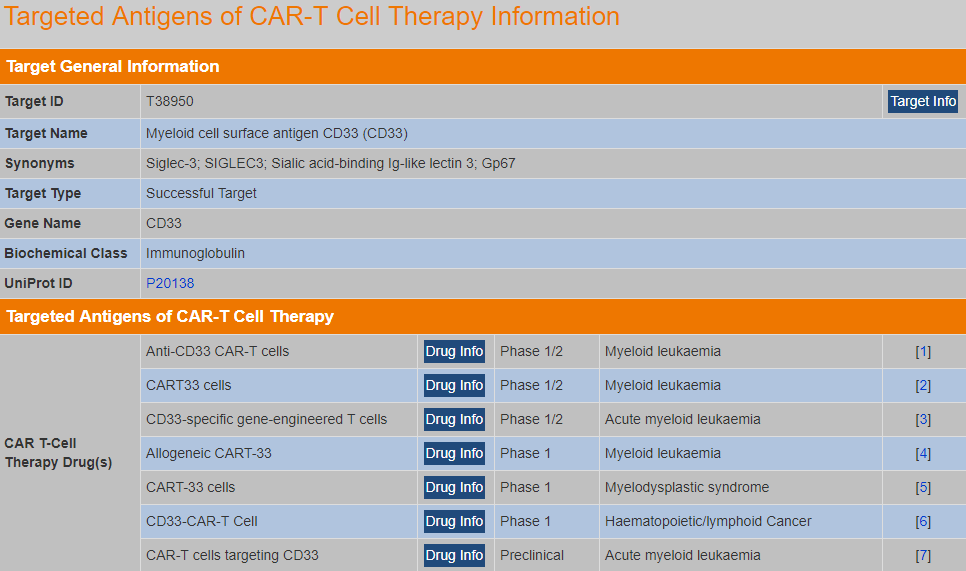
21. Search the Targets Regulated by microRNA
The information that microRNA regulates target is important for systems pharmacology, druggability studies and multi-target therapeutics via inhibiting translation of target protein.
There are 587 microRNAs regulate 177 successful, 298 clinical trial, 38 patent and 355 research targets (patent targets refer to the targets of patented therapeutic agents in early development). Users can identify information that microRNA regulates target by searching microRNA name, target name, target family, disease, ICD-11 code and so on or by drop-down lists among the entire textual component of TTD.
For example, if you search "VEGFA", you will find only entry with targets regulated by the microRNA. You can click "miRNA info" to get detail information that microRNA regulates target, which includes two components of target general information and the microRNAs regulating this target. The former includes Target ID, Target Name, Synonyms, Target Type, Gene Name, Biochemical Class and UniProt ID.

The latter includes miRNA Mature ID, miRNA Mature AC, Sequence, Supporting Experiment(s), Description and Representative Target(s) Regulated by This miRNA.

And you can get more specific miRNA information by clicking "miRNA Info". In new page, additionally, TTD target(s) regulated by this miRNA and protein(s) regulated by this miRNA also are presented.
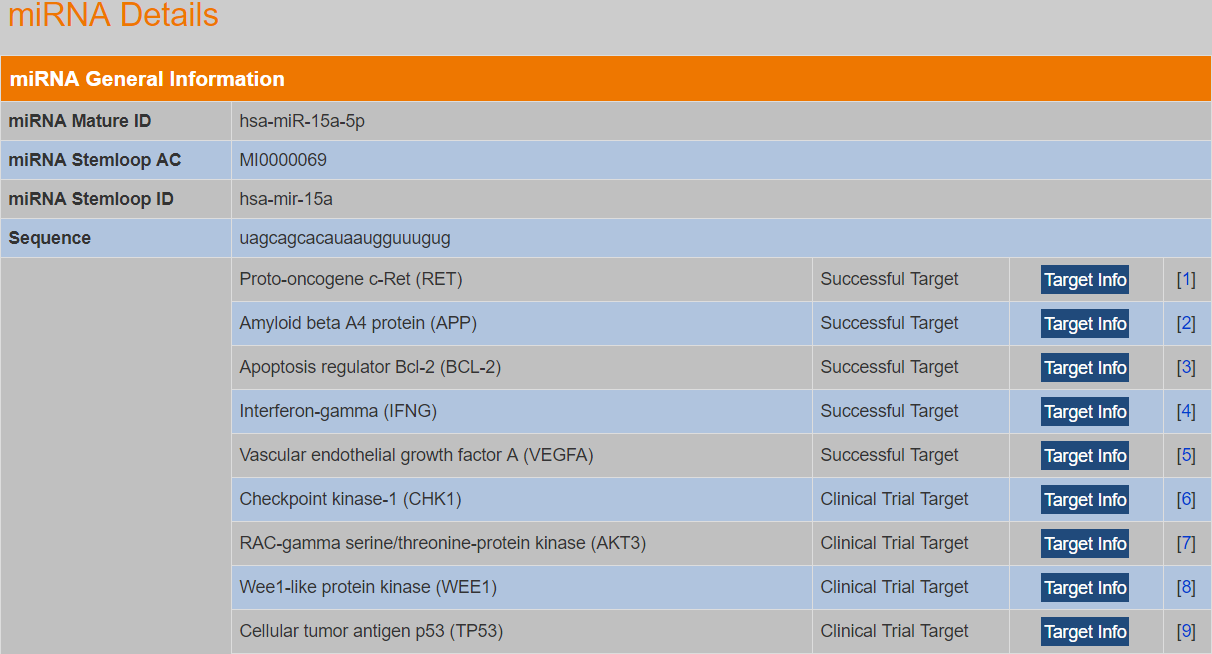
22. Search the Targets Regulated by Transcription Factor
The information that transcription factor regulates target is important for systems pharmacology, druggability studies and multi-target therapeutics via affecting transcription of target protein.
There are 135 transcription factors regulating 54 successful, 62 clinical trial, 4 patent and 33 research targets. Users can identify information that transcription factor regulates target by searching transcription factor name, target name, target family, disease, ICD-11 code and so on or by drop-down lists among the entire textual component of TTD.
For example, if you search "MMP-2", you will find only entry with targets regulated by the transcription factor. And you can click "TF Info" to get detail information that transcription factor regulates target, which includes two components of target general information and the transcription factors (TFs) regulating this target.
The former includes Target ID, Target Name, Synonyms, Target Type, Gene Name, Biochemical Class and UniProt ID.

The latter includes TF Name, Classification, Supporting Experiment(s), UniProt ID, Sequence and Representative Target(s) Regulated by This Transcription Factor.
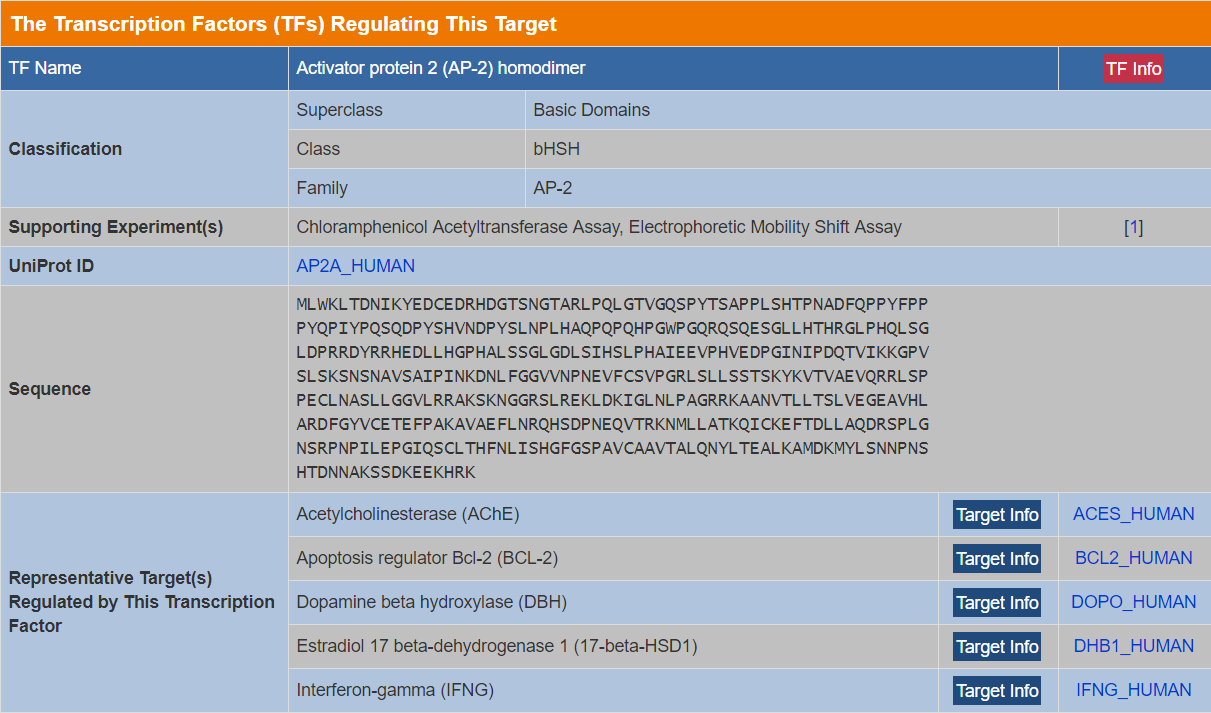
23. Search Target Interacting Proteins
There are 2,508 interacting proteins of 139 successful, 276 clinical trial, 59 patent and 425 research targets. Users can identify targets interacting proteins by searching interacting protein name, target name, target family and so on or by drop-down lists among the entire textual component of TTD.
For example, if you search "PPAR-gamma", you will find three entries with targets interacting proteins. And you can click "Interacting Protein Info" to get detail with target interacting protein information, which includes two components of target general information and target interacting proteins. The former includes Target ID, Target Name, Synonyms, Target Type, Gene Name, Biochemical Class and UniProt ID.
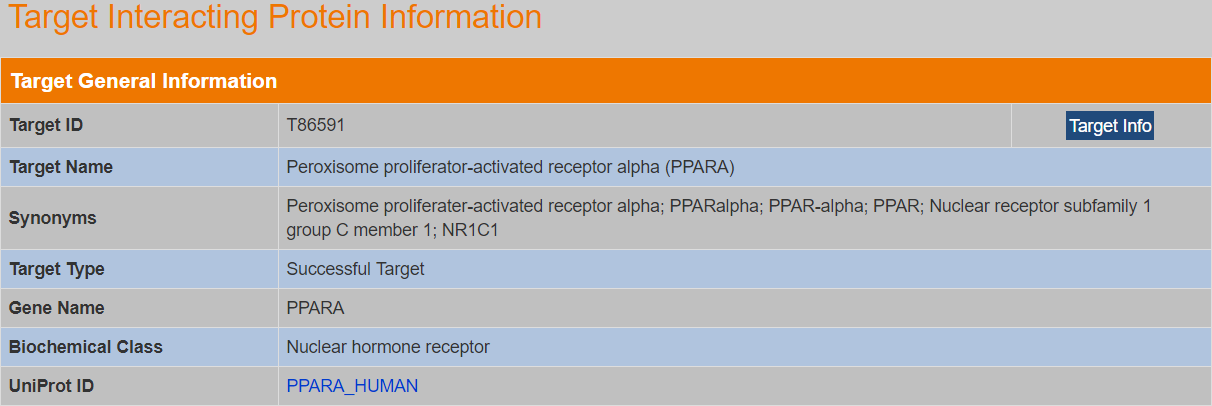
The latter includes Interacting Target Name, UniProt ID, Synonyms and Experiment(s).

And you can get more specific targets interacting proteins information by clicking "Interacting Protein Info". In new page, Protein General Information (TTD Target) and Interacting TTD Target Information are presented. Besides, interacting successful, clinical trial and research targets are listed, respectively.
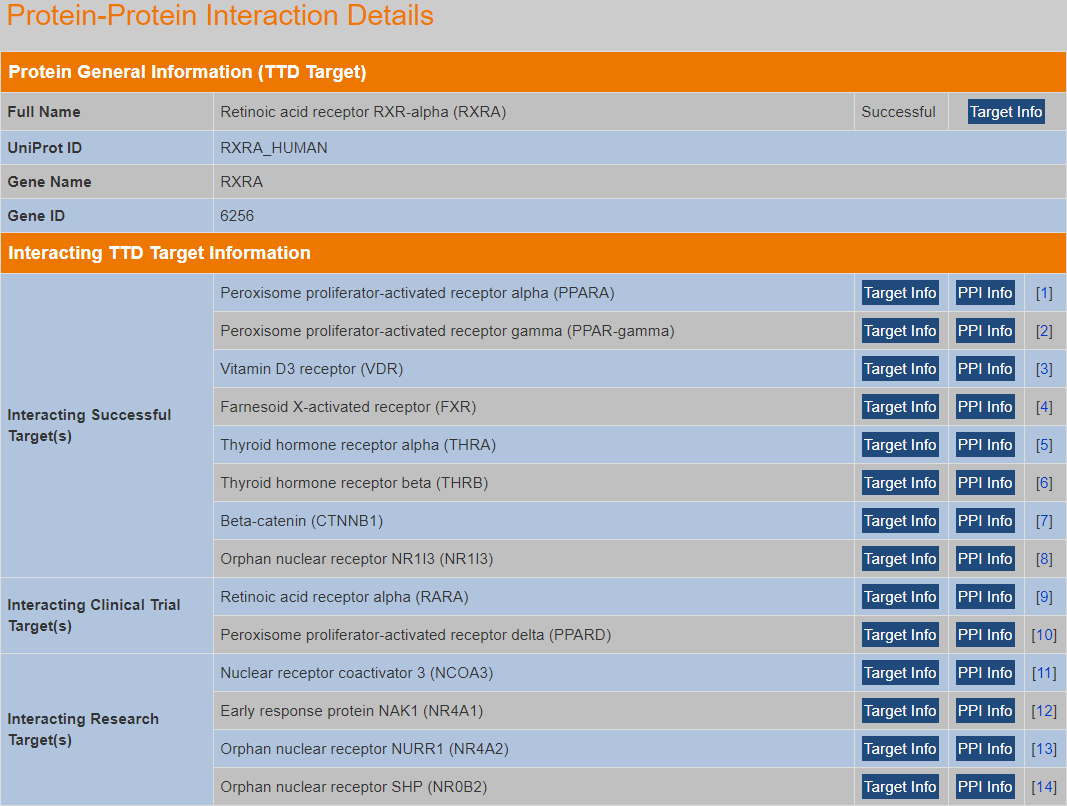
24. Search Chemical Structure Based Activity Landscape of Target
In this filed, TTD provides the information on 1,565 targets (444 successful, 469 clinical trial, 163 preclinical/patented and 489 research targets) with chemical structure based activity landscape.
Users can search by target name, disease name and so on in “Search Chemical Structure based Activity Landscape of Target” or by drop-down lists among the entire textual component of TTD. Search result lists all target(s) that are associated with the users’ input and have the information of chemical structure based activity landscape. The Target Info button links to target information page and displays chemical structure based activity landscape of the target.
For example, if you want to know the chemical structure based activity landscape of EGFR, you can search "EGFR" in the "Search Chemical Structure based Activity Landscape of Target " field.

Search result shows that “EGFR” target has the information of chemical structure based activity landscape. The Target Info button links to the detailed target information page of EGFR and displays its chemical structure based activity landscape.

The “Chemical Structure based Activity Landscape of Target” part in “Target Information” page displays the activity landscape of drugs/compounds with activity on EGFR. All drugs/compounds are clustering based on their 2D chemical structure by using Pubchem fingerprint. Drugs are highlighted by different color according to their highest status such as approved and clinical trial. Click the one or more legend(s) can show/hide all the drugs with the corresponding status. And move the mouse over the bar, the information including activity about the corresponding drug will display. To make it more convenient for users, the figure can be opened in a new window and can also be saved to local.

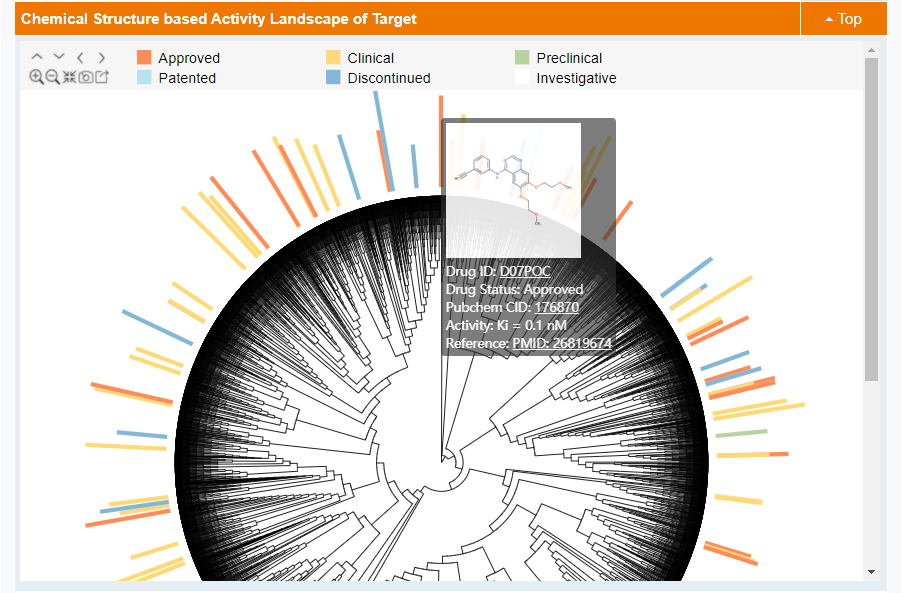
25. Search Drug Property Profile of Target
In this filed, TTD provides the information on 1,102 targets (435 successful, 356 clinical trial, 125 preclinical/patented and 186 research targets) with drug property profile.
Users can search by target name, disease name and so on in “Search Drug Property Profile of Target” or by drop-down lists among the entire textual component of TTD. Search result lists all target(s) that are associated with the users’ input and have information of drug property profile of target. The Target Info button links to detailed target information page and displays drug property profile of the target.
For example, if you want to know the drug property profile of targets associated with rheumatoid arthritis, you can search “rheumatoid arthritis” in the "Search Drug Property Profile of Target" field.

Search result shows all targets that are associated with “Rheumatoid arthritis” and have the information of drug property profile. The Target Info button links to the target information page with selected target and displays the drug property profile of the target.

The “Drug Property Profile of Target” part in “Target Information” page consists of two section (1) Lipinski RO5-based and (2) six single property (including molecular weight, octanol/water partition coefficient, hydrogen bond donor count, hydrogen bond acceptor count, rotatable bond count, and topological polar surface area) based drug clustering of the target. Drugs are highlighted by different color according to their highest status such as approved and clinical trial in each figure. Click the one or more legend(s) can show/hide all the drugs with the corresponding status. And move the mouse over the heatmap/bar, the corresponding drug property information will display. To make it more convenient for users, the figure can be opened in a new window and can also be saved to local.
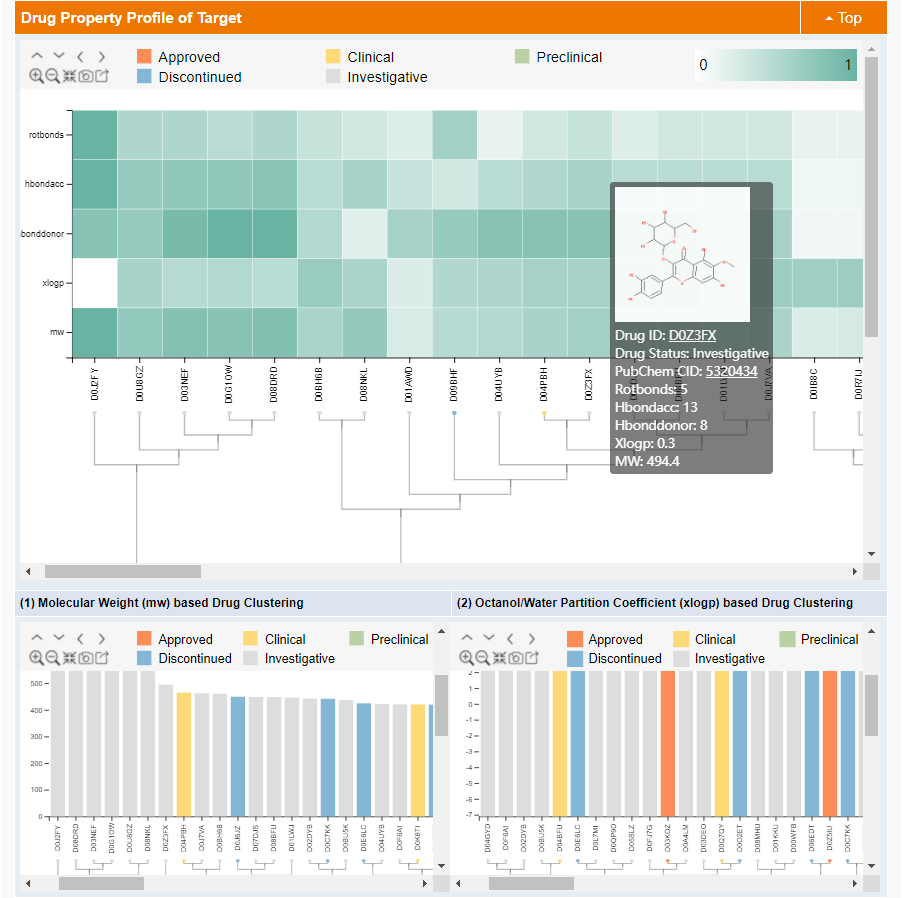
26. Search Co-Targets of Target
In this filed, TTD provides the information on 672 targets (423 successful and 249 clinical trial targets) with co-targets based on 642 approved and 624 clinical trial drugs.
Users can search by target name, disease name and so on in " Search Co-Targets" field. Users can also search by drop-down lists among the entire textual component of TTD. Search result lists all targets that are associated with the users’ input and have the information of co-targets. The Co-Target Info button links to co-target(s) information that displays co-targets of the target.
For example, if you want to know the co-targets of 5-HT 1A receptor, you can search "5-HT 1A receptor" in the "Search Co-Targets" field.

Search result shows that “5-HT 1A receptor” has the information of co-target. The Co-Target Info button links to the co-target(s) information page of 5-HT 1A receptor.

In Co-Target(s) Information page, Target General information displays Target Synonyms, Target Type, Gene Name, Biochemical Class, and UniProt ID.
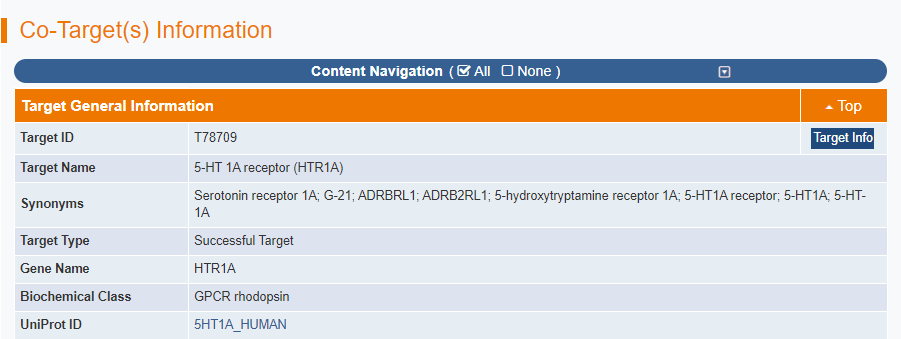
Co-Targets of This Target display the co-targets with co-target name, UniProt ID, gene name, synonyms and its representative drug(s) that modulated the co-targets with 5-HT 1A receptor and its experimental activity value. Moreover, the Click to Show More button can be clicked if this co-target has more than one representative drug(s). Drug Info button links to the detail information page with the drug.
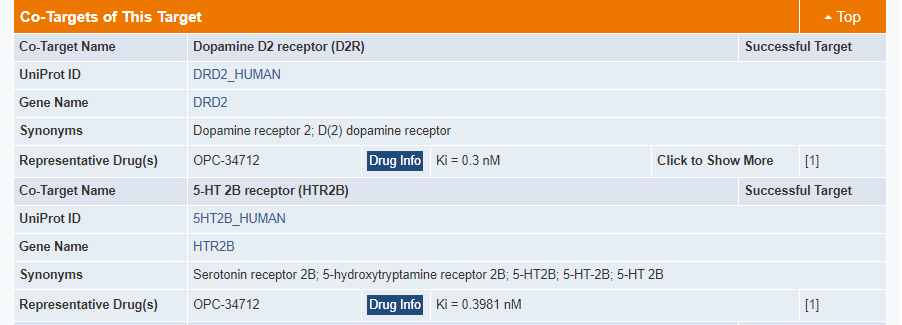
27. Search Very Weak or Non Binders of Target
In this filed, TTD provides the information on 1,243 targets (383 successful, 392 clinical trial, 137 preclinical/patented and 331 research targets) with very weak binders and 870 targets (309 successful, 275 clinical trial, 91 preclinical/patented and 195 research targets) with non binders.
Users can search by target name, target family, disease name and so on in " Search Co-Targets" field. Users can also search by drop-down lists among the entire textual component of TTD. Search result lists all targets that are associated with the users’ input and have the information of very weak or non binders. The Target Binder Info button links to target very weak or non binder(s) information page.
For example, if you want to know the very weak or non binders of target that belongs to acyltransferase, you can search "Acyltransferase" in the "Search Co-Targets" field.

Search result lists acyltransferases that has the information of very weak or non binders. The Target Binder Info button links to very weak or non binder(s) information page.

In Target Very Weak or Non Binder(s) Information, Target General information displays Target Synonyms, Target Type, Gene Name, Biochemical Class, and UniProt ID.

Very Weak Binders of This Target/Non Binders of This Target displays the very weak binders/non binders with compound name, synonyms, and its experimental activity value on the target. Moreover, the Click to Show/Hide the Information of All Very Weak Binders/Non binders button can be clicked if this target has more than five very weak binders/non binders. Compound Info button links to the detail information page with the compound.

28. Search prodrugs
In this filed, TTD provides the 534 prodrug-parent drug pair information (146 approved, 79 clinical trial, 9 preclinical and 300 experimental prodrugs).
Users can search by prodrug name, target name, disease name, bioconversion enzyme and so on in "Search Prodrugs" field. Users can also search by drop-down lists among the entire textual component of TTD. Search result lists prodrug(s) that associates with the users’ input. The Prodrug Info button links to detail prodrug information page.
For example, if you want to know the prodrugs that converted by “Alkaline phosphatase”, you can search " Alkaline phosphatase" in the " Search Prodrugs" field.

Search result lists prodrugs that converted by “alkaline phosphatase”. The Prodrug Info button links to Prodrug Information page.
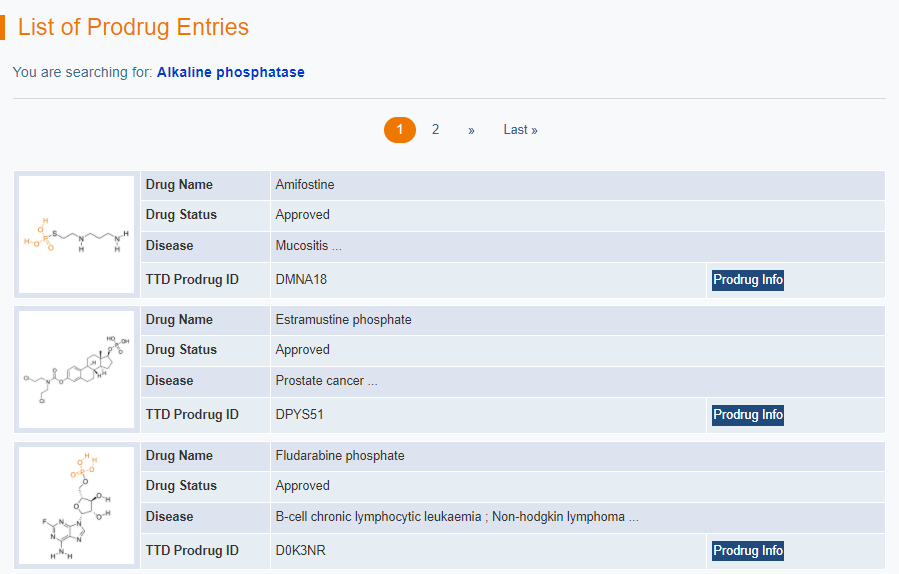
Prodrug General Information displays the structure transformation (png, 2D mol and 3D mol if available) from prodrug to parent drug. Prodrug strategy, bioconversion enzyme and description are also provided for the prodrug-parent drug pairs. Besides, basic chemical information including formula, canonical SMILES, InChI, InChIKey, CAS Number, PubChem compound ID, ChEBI ID is offered.

Parent Drug General Information displays synonyms, Formula, Canonical SMILES, InChI, InChIKey, CAS Number, PubChem Compound ID, ChEBI ID of the parent drug.
